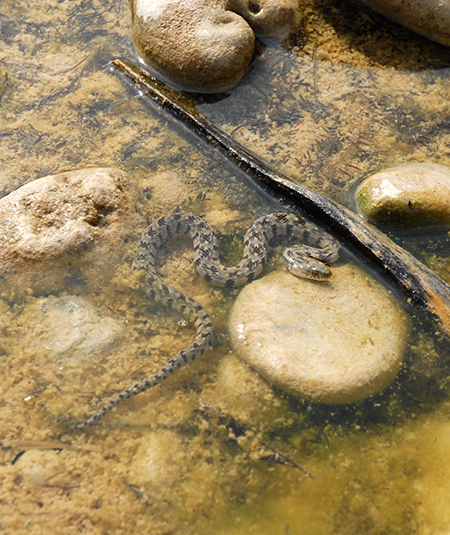
PICTURED IS A “DIAMOND-BACK WATER SNAKE,” a common, non-venomous but occasionally aggressive reptile. Venture close enough, and you might get bitten. They’re a threat to any fish on a stringer, and will sometimes hold their position, but are not normally aggressive toward humans, unless threatened. If bitten by any snake, seek medical attention quickly, but calmly, taking identifying evidence of the snake with you. (Photo by John Jefferson)
by John Jefferson
Nature has countless obstacles, along with the delightful pleasure of being out in it. Snakes are part of it.
Rattlesnakes inhabit almost all of Texas. Cottonmouth water moccasins – short, fat, dark colored critters — are in and around practically every waterbody, large and small. Copperheads may be the most dangerous since they are easily camouflaged in dry leaves or pine needles, have potent venom, and are easily stepped on or sat upon. Or near.
A female turkey hunter once told me she answered Nature’s call in the pre-dawn darkness one morning before settling into her turkey blind for several hours. She felt something sharp and figured she had been scratched by a sharp limb on the ground, or maybe green briar. It has wicked thorns. Later, in the shower, she let out a scream when the hot water hit her – uh — backside. She had been snake-bitten. Probably a copperhead lying in the leaves. She said tissue sloughed off for six months afterwards.
Coral snakes with their body’s red and yellow bands touching each other are seldom seen and aren’t as aggressive as Texas’ other three venomous snakes. But their powerful venom can be deadly. Most shyly move away as you approach, though.
If bitten by any snake, get to a doctor quickly (but calmly), taking either the DEAD snake or a picture of it for identification. I don’t harass non-poisonous snakes, but if bitten by one, I’d take identifying evidence for the medical staff. A good, close-up photo is probably good enough evidence, provided you get enough light on the subject.
A med student working in a small medical clinic in southeast Texas while attending medical school told of a man who came in saying he had been snake bitten. He said he brought the reptile that bit him for identification. The “doc” asked where it was. The man lifted his forearm which was rapped tightly with a towel. The man said “All I could do was wrap it quickly with my other arm before it got away.”
That caused a little excitement untii the “doc,” who was a hunter, declared it a non-poisonous water snake. The man was treated for possible infection and released.
My eldest son lives in a fashionable neighborhood in old West Austin. He went out to the garage about bedtime at the end of June, this year, and discovered a huge snake. It was against the wall with its head at one two-by-four strut and its tail by another. He recognized it as a rat snake, and just shooed it out of the garage. He stepped off the distance between the two-by-fours. The snake was six-feet-long.
Rat snakes are one of the most beneficial snakes in Texas. They help control rats and mice. Big ones are also among the most frightening to encounter. I’ve heard numerous big rat snake reports lately. But none from Tarrytown which has little traditional snake habitat.
Rat snakes can turn up anywhere — even in Tarrytown. Especially when hungry.
JJ
Congratulations to columnist John Jefferson for his National Newspaper Award! Click here for details.




